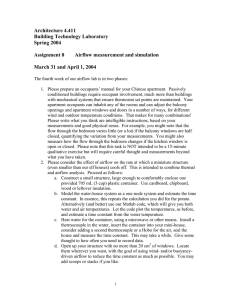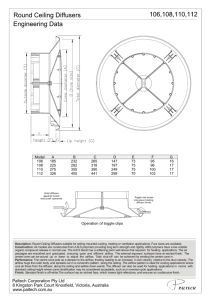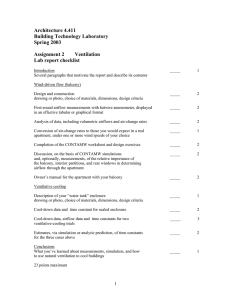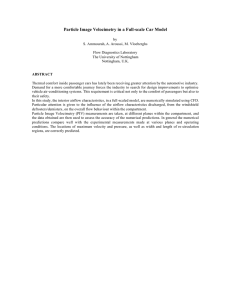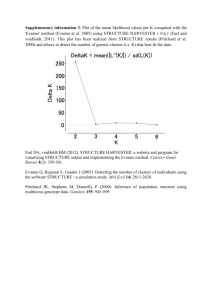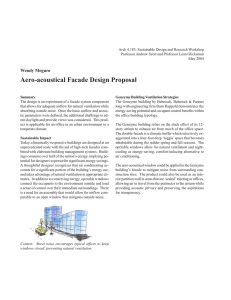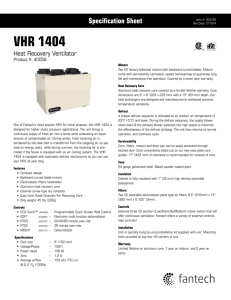AIRFLOW ENERGY HARVESTER FOR WIRELESS SENSING IN AIR DUCTS
advertisement
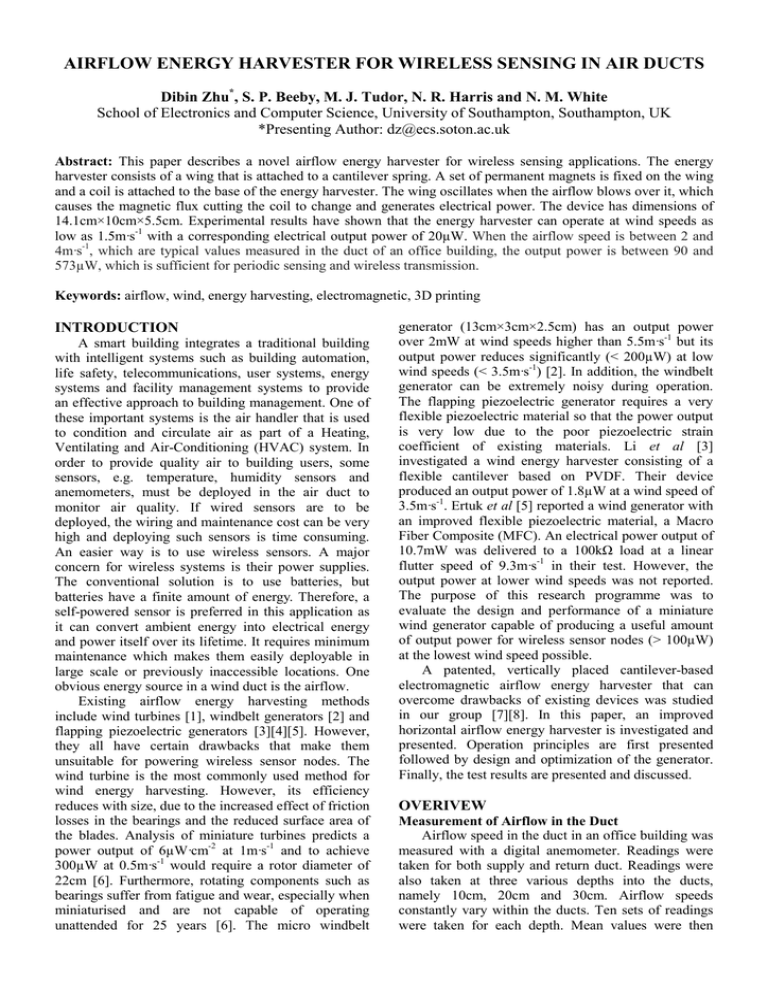
AIRFLOW ENERGY HARVESTER FOR WIRELESS SENSING IN AIR DUCTS Dibin Zhu*, S. P. Beeby, M. J. Tudor, N. R. Harris and N. M. White School of Electronics and Computer Science, University of Southampton, Southampton, UK *Presenting Author: dz@ecs.soton.ac.uk Abstract: This paper describes a novel airflow energy harvester for wireless sensing applications. The energy harvester consists of a wing that is attached to a cantilever spring. A set of permanent magnets is fixed on the wing and a coil is attached to the base of the energy harvester. The wing oscillates when the airflow blows over it, which causes the magnetic flux cutting the coil to change and generates electrical power. The device has dimensions of 14.1cm×10cm×5.5cm. Experimental results have shown that the energy harvester can operate at wind speeds as low as 1.5m·s-1 with a corresponding electrical output power of 20µW. When the airflow speed is between 2 and 4m·s-1, which are typical values measured in the duct of an office building, the output power is between 90 and 573µW, which is sufficient for periodic sensing and wireless transmission. Keywords: airflow, wind, energy harvesting, electromagnetic, 3D printing INTRODUCTION A smart building integrates a traditional building with intelligent systems such as building automation, life safety, telecommunications, user systems, energy systems and facility management systems to provide an effective approach to building management. One of these important systems is the air handler that is used to condition and circulate air as part of a Heating, Ventilating and Air-Conditioning (HVAC) system. In order to provide quality air to building users, some sensors, e.g. temperature, humidity sensors and anemometers, must be deployed in the air duct to monitor air quality. If wired sensors are to be deployed, the wiring and maintenance cost can be very high and deploying such sensors is time consuming. An easier way is to use wireless sensors. A major concern for wireless systems is their power supplies. The conventional solution is to use batteries, but batteries have a finite amount of energy. Therefore, a self-powered sensor is preferred in this application as it can convert ambient energy into electrical energy and power itself over its lifetime. It requires minimum maintenance which makes them easily deployable in large scale or previously inaccessible locations. One obvious energy source in a wind duct is the airflow. Existing airflow energy harvesting methods include wind turbines [1], windbelt generators [2] and flapping piezoelectric generators [3][4][5]. However, they all have certain drawbacks that make them unsuitable for powering wireless sensor nodes. The wind turbine is the most commonly used method for wind energy harvesting. However, its efficiency reduces with size, due to the increased effect of friction losses in the bearings and the reduced surface area of the blades. Analysis of miniature turbines predicts a power output of 6µW·cm-2 at 1m·s-1 and to achieve 300µW at 0.5m·s-1 would require a rotor diameter of 22cm [6]. Furthermore, rotating components such as bearings suffer from fatigue and wear, especially when miniaturised and are not capable of operating unattended for 25 years [6]. The micro windbelt generator (13cm×3cm×2.5cm) has an output power over 2mW at wind speeds higher than 5.5m·s-1 but its output power reduces significantly (< 200µW) at low wind speeds (< 3.5m·s-1) [2]. In addition, the windbelt generator can be extremely noisy during operation. The flapping piezoelectric generator requires a very flexible piezoelectric material so that the power output is very low due to the poor piezoelectric strain coefficient of existing materials. Li et al [3] investigated a wind energy harvester consisting of a flexible cantilever based on PVDF. Their device produced an output power of 1.8µW at a wind speed of 3.5m·s-1. Ertuk et al [5] reported a wind generator with an improved flexible piezoelectric material, a Macro Fiber Composite (MFC). An electrical power output of 10.7mW was delivered to a 100kΩ load at a linear flutter speed of 9.3m·s-1 in their test. However, the output power at lower wind speeds was not reported. The purpose of this research programme was to evaluate the design and performance of a miniature wind generator capable of producing a useful amount of output power for wireless sensor nodes (> 100µW) at the lowest wind speed possible. A patented, vertically placed cantilever-based electromagnetic airflow energy harvester that can overcome drawbacks of existing devices was studied in our group [7][8]. In this paper, an improved horizontal airflow energy harvester is investigated and presented. Operation principles are first presented followed by design and optimization of the generator. Finally, the test results are presented and discussed. OVERIVEW Measurement of Airflow in the Duct Airflow speed in the duct in an office building was measured with a digital anemometer. Readings were taken for both supply and return duct. Readings were also taken at three various depths into the ducts, namely 10cm, 20cm and 30cm. Airflow speeds constantly vary within the ducts. Ten sets of readings were taken for each depth. Mean values were then taken to represent the airflow at a particular depth of a particular duct during a particular time. Measurements were repeated hourly from 8:30am until 4:30pm. It was found that typical airflow speed in the duct in an office building is between 2 and 4m·s-1. 3(c). When the cantilever springs back to the initial position, the wing is exposed to the full airflow again, energy is once again extracted from the airflow and the cycle is repeated. By appropriate design and positioning of the bluff body, and by tuning the resonant frequency of the cantilever spring, the system resonates. cantilever wing Bluff body (a) No air flow Fig. 1: Airflow speeds measured in the duct in an office building. Airflow Energy Harvester Fig. 2 shows a photo of the airflow energy harvester. The device consists of a wing, with four permanent magnets, attached to a cantilever spring. A coil is placed on the base of the energy harvester to induce electric current when the magnets move. A bluff body is placed in front of the wing. The existence and position of the bluff body is important to the operation of the airflow energy harvester. Air flow Vortex (b) Cantilever bent due to air flowing Oscillating motion Air flow (c) Cantilever sprung back Fig. 3: Operational principle of the airflow energy harvester. Fig. 2: Energy harvester from airflow. PRINCIPLE Oscillation under Airflow There is an initial downward displacement of the wing due to gravity as shown in Fig. 3(a). The air flowing over the wing causes the cantilever to bend as shown in Fig. 3(b), the degree of bending being a function of the lift/drag force from the aerofoil and the spring constant. Under normal conditions this is a static deflection, but this can become dynamic by causing the lift force to be asymmetric with deflection about the zero axis, i.e. to vary with the direction of deflection of the cantilever. This is achieved by placing a bluff body, which produces vortices below the cantilever. As the cantilever deflects, the bluff body reduces the flow of air and the lift force reduces, hence causing the cantilever to operate primarily under inertial effects and so spring back as shown in Fig. Electromagnetic Transducer The magnetic circuit of the energy harvester is shown in Fig. 4. Two mild steel keepers were used to couple the magnetic flux between the top and bottom magnets, which ensured a uniform magnetic field within the air gap. The coil was attached to the base. The four-magnet structure was fixed to a cantilever beam and oscillates with the wing. The magnets moved with respect to the static coil so that the induced current was generated within the coil according to the Faraday’s law. Fig. 4: Cross section of the four-magnet arrangement. DESIGN AND FABRICATION Design of the Energy Harvester Based on experience in designing previous airflow energy harvesters [8], some more simulation was conducted using ANSYS fluid-structure interaction analysis to optimize design of the airflow energy harvester. Both ANSYS Mechanical and ANSYS CFX tools were used in the simulation. Wings with various cross sections have been studied for the optimised design. It was found that the wing with a triangular cross section has the best aerodynamic performance in this application. The operation of this airflow energy harvester is largely dependent on the vertical and horizontal distances between the airfoil and the bluff body, a and b, respectively, as well as the elevation angle, α, as shown in Fig. 5. Table 1 to 3 show the relationship of these variables with the starting wind speed of the energy harvester. The starting wind speed here is defined as the wind speed at which the peak-to-peak movement of the wing is over 3 cm. Fig. 5: Optimisation of the airflow energy harvester. Table 1: Starting wind speed vs. vertical distances between the wing and bluff body, a (b = 10 mm, α = 30°). a (mm) Airflow speed (m·s-1) 2 5 8 11 14 17 20 23 5 3 3 5 6 7 8 8 Simulation results provided the optimum values for vertical and horizontal distances between the wing and the bluff body, a and b, respectively, as well as the elevation angle, α as listed in Table 4. Table 4: Optimum values from simulation. Vertical distances between the airfoil and bluff body, a : horizontal distances between the airfoil and bluff body, d : Elevation angle, α : 5 - 8 mm 4 - 10 mm 30 - 35° Fabrication of the Energy Harvester The base of the energy harvester and the wing were fabricated using Objet Connex350TM multimaterial 3D printer. Each component is printed with multiple 16µm-thick photopolymer layers. Each photopolymer layer is cured by UV light immediately after it is printed. The material used is rigid enough for this application. The cantilever is made of 0.3mm-thick BeCu that has good fatigue characteristics. The four magnets are NdFeB to provide strong magnetic field. The coil is wound with 50µm-thick copper wire. Its outer and inner diameters are 15mm and 1mm, respectively and it is 8mm thick. The coil has approximately 16000 turns. The total mass of the resonator was measured as 72.7 grams. The overall dimensions of the device were 14.1cm×10cm×5.5cm. EXPERIMENT AND DISCUSSION Fig. 6 shows the wind tunnel used in the test. To generate laminar air flow in the tunnel, a centrifugal fan was used. The wind tunnel had an opening of 25cm×15 cm. The fan can provide air flow of up to 10m·s-1. Table 2: Starting wind speed vs. horizontal distances between the airfoil and bluff body, b (a = 8 mm, α = 30°). b (mm) Airflow speed (m·s-1) 1 4 7 10 13 16 19 5 3 3 3 4 5 6 Fig. 6: Wind tunnel. Table 3. Starting wind speed vs. elevation angles, α (a = 8 mm, b = 10 mm). α (°) 5 10 15 20 25 30 35 40 Airflow speed (m·s-1) 6 5 5 4 4 3 3 5 Fig. 7 shows the open circuit voltage of the energy harvester. The open-circuit voltage increases with the airflow speed. When the airflow speed is higher than 5.5m·s-1, the airflow holds the wing at a certain position because there is no electrical damping and the lift force exceeds the spring force. Fig. 7: Open circuit voltage of the airflow energy harvester. Fig. 8 shows that output power also increases with increasing airflow speeds. The energy harvester starts working from an airflow speed of only 1.5m·s-1 when it produces an output power of 20µW. This start-up airflow speed is lower than that of competing approaches of the same size. When the airflow speed is between 2 and 4m·s-1, which are typical values measured in the duct in an office building, the output power is between 90 and 573µW, which is sufficient for periodic sensing and wireless transmission. Fig. 9 shows that the optimum load resistance reduces with the increase of airflow speed. This is due to the fact that the stronger the airflow, the larger the force on the wing available to overcome total damping, and so more energy can be extracted for a given displacement. airflow energy harvester, which was designed to power wireless sensors in air ducts. Experimentally, it started working at a low wind speed of only 1.5m·s-1 and produced a minimum output power of 90µW at the airflow of 2m·s-1 and above. For the flapping airflow energy harvester, it is important to limit the displacement of the wing, especially when the airflow speed is high, in order to extend the lifespan of the device. This can be realized by controlling the electrical damping by varying the electrical load. To achieve this, the transducer must have high coupling, such as the device presented here. However, high electromagnetic coupling may reduce output power at low wind speeds. There is thus a tradeoff between degree of electromagnetic coupling and the minimum working airflow speed. This needs to be taken into consideration in future design of such airflow energy harvesters. Future work includes reducing the size of the energy harvester while maintaining useful output power level. REFERENCES [1] [2] [3] [4] [5] Fig. 8: Output power of the airflow energy harvester. [6] [7] [8] Fig. 9: Optimum resistive load of the airflow energy harvester. CONCLUSION This paper presents an improved electromagnetic Joselin Herberta G M, Iniyanb S, Sreevalsanc E, and Rajapandian S 2007 A review of wind energy technologies Renewable and Sustainable Energy Reviews 11 S1117-S1145 http://www.humdingerwind.com, Webpage accessed on 8th September, 2011 Li S and Lipson H 2009 Vertical-Stalk Flapping-Leaf Generator For Parallel Wind Energy Harvesting Proceedings of the ASME/AIAA 2009 Conference on Smart Materials, Adaptive Structures and Intelligent Systems, SMASIS 2009 (Oxnard, California,USA, 21–23 September 2009) Tang L, Paidoussis M P and Jiang J 2009 Cantilevered flexible plates in axial flow: Energy transfer and the concept of flutter-mill Journal of Sound and Vibration 326 S263–S276 Erturk A, Vieira W G R, De Marqui Jr. C and D. Inman J 2010 On the energy harvesting potential of piezoaeroelastic systems Applied Physics Letters 96 184103 Mitcheson P D, Yeatman E M, Rao G K, Holmes A S and Green T C 2008 Energy Harvesting From Human and Machine Motion for Wireless Electronic Devices Proceeding of the IEEE 96(9) S1457-S1486 Tudor M J, White N M, Beeby S P and Harris N R 2010 Generator for converting fluid energy to electrical energy WO/2010/043617, PCT/EP2009/063349, April 2010 Zhu D, Beeby S, Tudor J, White N and Harris N 2010 A novel miniature wind generator for wireless sensing applications, Proceedings of IEEE Sensors 2010 (Waikoloa, Hawaii, USA, 14 November 2010)
